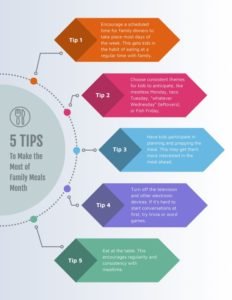Set Your Table for National Family Meals Month
National Family Meals Month happens annually in September and is the perfect segue to Kid’s Health Month in October. While families may be busier than ever with multiple jobs, sports teams, and community activities, sitting down and enjoying food and conversation together is vital to good health. And not just for kids.Family meals offer a wealth of health from head to toe. Keep reading to learn more!Defeat DepressionDid you know that eating regular meals helps fight depression in teens? A national study with 8500 students evaluated the connection between family meals and teenage mental health. Roughly 60% of teens had family meals 5 times or more per week while 22% had meals less than twice per week. More frequent family meals were linked with fewer symptoms of depression, fewer emotional difficulties, and improved emotional well-being. When compared between the sexes, the relationship was stronger for girls than boys. 1A Canadian study of nearly 1500 children examined the association between early family meals (at age 6) and behaviors at age 10 including scholastic achievement, lifestyle habits, and social adjustment. Researchers noted that the quality of the family meal environment at a young age resulted in better levels of fitness, reduced consumption of soft drinks, and lower levels of physical aggression, oppositional behavior, nonaggressive delinquency, and reactive aggression by age 10. 2Older studies also support family mealtime in reducing at-risk behaviors including drug use and suicide. A survey of nearly 99,500 students aged 12 to 18 from public and alternative schools across the US evaluated family dinner frequency and developmental assets including positive values, social competencies, positive identity, and commitment to learning. An inverse relationship was consistently seen between how often students ate family dinner and all high-risk behaviors such as substance abuse, sexual activity, depression, and suicide, to name a few. 3Desirable Diet In addition to family meals being great for mental health, they’re also beneficial in promoting optimal nutrition in children. A recent review of studies indicated that family meal frequency was positively associated with increased intake of more nutrient-dense foods and a balanced diet. More structured meals and meal times were linked with less fussiness and emotional eating, and more food enjoyment in infants and toddlers. 4Another study examined the characteristics of healthy meals in 272 young children in a low-income area of Michigan. Meal variables included TV use, eating at the table, family-style meals, and the presence of a parent. Results showed higher diet quality when the TV was off, family-style meals were served and the family was eating at a table. A parent partaking in the meal did not impact Healthy Meal Index (HMI) scores. 5How can healthcare providers encourage more family meals? Check out the tips below and delicious recipes to follow this month:
- Encourage a scheduled time for family dinners to take place most days of the week. This gets kids in the habit of eating at a regular time with family.
- Choose consistent themes for kids to anticipate like meatless Monday, taco Tuesday, “whatever Wednesday” (leftovers), or Fish Friday.
- Have kids participate in planning and prepping the meal. This may get them eggcited about the meal ahead.
- Turn off the tube and other electronic devices. Family meals are meant for conversations, not digital presentations.
- Make meals simple. If time is an issue, pick up a rotisserie chicken and serve it with salad or frozen veggies and rice.
- Eat at the table. This encourages regularity and consistency with mealtime.
Stay tuned for simple meal ideas this month!By Lisa Andrews, MEd, RD, LDReferences:
- Utter J, Denny S, Peiris-John R, Moselen E, Dyson B, Clark T. Family Meals and Adolescent Emotional Well-Being: Findings From a National Study. J Nutr Educ Behav. 2017 Jan;49(1):67-72.e1. doi: 10.1016/j.jneb.2016.09.002. Epub 2016 Oct 26. PMID: 28341017.
- Harbec MJ, Pagani LS. Associations Between Early Family Meal Environment Quality and Later Well-Being in School-Age Children. J Dev Behav Pediatr. 2018 Feb/Mar;39(2):136-143. doi: 10.1097/DBP.0000000000000520. PMID: 29227338.
- Fulkerson JA, Story M, Mellin A, Leffert N, Neumark-Sztainer D, French SA. Family dinner meal frequency and adolescent development: relationships with developmental assets and high-risk behaviors. J Adolesc Health. 2006 Sep;39(3):337-45. doi: 10.1016/j.jadohealth.2005.12.026. Epub 2006 Jul 10. PMID: 16919794.
- Verhage CL, Gillebaart M, van der Veek SMC, Vereijken CMJL. The relation between family meals and health of infants and toddlers: A review. Appetite. 2018 Aug 1;127:97-109. doi: 10.1016/j.appet.2018.04.010. Epub 2018 Apr 11. PMID: 29654851.
- Kasper N, Ball SC, Halverson K, Miller AL, Appugliese D, Lumeng JC, Peterson KE. Deconstructing the Family Meal: Are Characteristics of the Mealtime Environment Associated with the Healthfulness of Meals Served? J Acad Nutr Diet. 2019 Aug;119(8):1296-1304. doi: 10.1016/j.jand.2019.01.009. Epub 2019 Mar 18. PMID: 30898585; PMCID: PMC6987980.
You didn't think I forgot your free handout, did you? Here it is: 5 Tips for Family Meals


